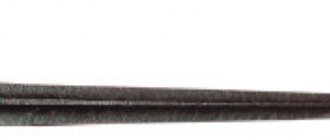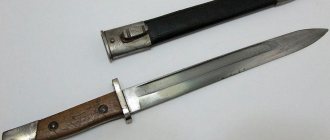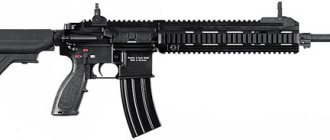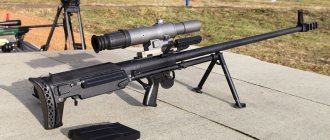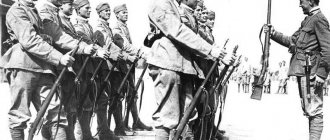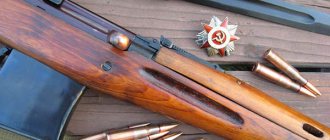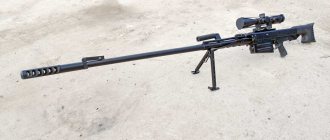Basil Gras single-shot rifle
For some reason, earlier innovations in handguns were taken more seriously and almost immediately such innovations ceased to be such, as they became more widespread. At that time, neither the high cost of production nor the individual shortcomings of the weapon stopped us, which were eliminated already when the weapon went into operation. I don’t argue that combat operations at the moment are very different even from those that existed in the mid-twentieth century, but the thought remains that before, a soldier’s life was valued more highly, because if a soldier can carry out a combat mission more quickly and successfully, then there is no chance of remaining he has more alive. At the moment, there is a huge number of a wide variety of developments that can significantly increase the effectiveness of certain classes of weapons, but due to the fact that production and re-equipment are too expensive, all these developments remain experimental and rarely go beyond the factory premises. So, for example, arrow-shaped bullets can significantly increase the efficiency of large-caliber machine guns and SWRs, which was already discussed in the article, but despite the fact that the idea is many years old, these weapons and ammunition have not been put into mass production for years. But when the first ammunition with a metal casing appeared, very little time passed before they became widespread, and this despite the high cost, the need to create new types of weapons or at least adapt existing ones. At that time, no one was frightened by the price of the issue or possible problems with a new, untested weapon, since they saw that such ammunition had a clear advantage over a paper cartridge. Let's try to get acquainted with one of the samples of weapons converted from a paper cartridge to a cartridge with a metal sleeve, namely, with a rifle and ammunition for it, proposed by Basil Gras.
The Gra rifle is a kind of product of the understanding that more advanced weapons lead the army to victory, although understanding this simple truth had to pay a high price, namely defeat in the Franco-Prussian War. Seeing that the main reason for the defeat was the lag in armament, it was decided to urgently rearm the army and, first of all, it was necessary to start with the adoption of a rifle chambered for a cartridge with a metal sleeve. Naturally, there was no money for either the cartridge itself or the weapon, and rearming an entire army was always quite a costly endeavor. The problem was partially solved by Captain Basil Gras, who proposed a relatively cheap solution to create a weapon chambered for a metal cartridge case, using the Chaspo rifle as a basis, but he already had to pay in full for the ammunition itself. By the way, the rifle cartridge is also the merit of Captain Gra. In fact, the solution was not the most original and many saved money in this way; however, the captain’s merits cannot be underestimated, especially considering that the resulting weapon was widespread at one time in Russia. In fact, the captain's main job was to create the bolt for the rifle and the cartridge; the drill work associated with the chamber can be ignored as a matter of course. Since the basis of any weapon is ammunition, that’s where we’ll start.
The cartridge was based on a bottle-shaped sleeve with a rim made of brass 59 millimeters long. The powder weighed 5.25 grams, but the most important thing was the bullet of this cartridge. The bullet was cast from pure lead and weighed 25 grams. Leaving the barrel of the weapon, this bullet accelerated to 448 meters per second, that is, the kinetic energy of the bullet was about 2500 Joules. Considering that the bullet is shellless, it is not difficult to imagine what kind of wounds it caused when it hit the enemy’s body, with such energy. Let's add to this a decent caliber of a bullet of just over 10 millimeters and we get the ideal ammunition for hitting an enemy unprotected by body armor. However, not everything was as perfect as it seems. The junction of the cartridge case and the bullet was sealed with a rather unreliable composition in the form of a mixture of wax and fat. As a result, in fairly hot weather, the whole thing “floated”, and since the bullet itself only held on to this composition in the case, the projectile could simply fall out of the case on its own. The only saving grace was that hot weather was far from a common occurrence. Another interesting point was that the cartridge primer was initially covered with a cap so that the cartridge would not accidentally fire, and also to protect the primer composition from moisture. This did not take long, and since this cap had to be removed to fire a shot, they came up with more reasonable methods for sealing the primer. In general, the cartridge turned out to be very good for its time and lasted much longer than other early ammunition with a metal sleeve, although it was constantly modernized.
As mentioned above, the Gra rifle is a modernized Chaspo rifle, in which the bolt was replaced, and the chamber was bored out for a metal sleeve. Even the bayonet of the weapon, which was a small saber, was left unchanged. The rifle bolt was a very simple and at the same time reliable design, which consisted of only 7 parts and did not have any threaded connections. Thus, disassembling the bolt required a matter of seconds, which was a positive quality of the weapon, since, thanks to its simplicity and ease of maintenance, absolutely anyone could handle it. The barrel bore was locked using the bolt ridge when rotated 90 degrees. Despite the apparent simplicity of the shutter design, it is easy to notice that it took a lot of time to manufacture it, and judging by the photographs, the quality of the processing of the parts is such that many modern manufacturers (I won’t point fingers) have a lot to learn, but all this was done against a common background the strictest economy. The extractor is a V-shaped spring, which with one end grabs the sleeve by the rim, and with the other, when closing the bolt, rests against the narrowing in the receiver. As a result, the second end of the spring reliably grips the rim of the cartridge case, which allows the cartridge case to be reliably removed after the shot, even if it has become deformed for some reason and is stuck in the chamber. Of considerable importance in all this is the thick bolt handle, which is convenient enough for the shooter to apply muscular strength to it.
The appearance of the weapon is largely due to the fact that the bayonet attack was an integral part of the battle of that time, so they tried to make the weapon as convenient as possible for working with a bayonet. The stock and butt of the rifle were made of walnut wood, the receiver was fastened with just one screw, and in addition, the barrel of the weapon was fixed with two rings. As mentioned above, the weapon’s bayonet was a small saber that could be quickly detached from the weapon and used separately from the rifle. An interesting point is that in the butt of the weapon there was a small capsule with holy water. Many consider this to be nothing more than a legend, but on absolutely all rifles, on the right side you can see a small plug in the butt. I personally don’t see any justified practical reasons for adding this part to the design, so why shouldn’t it be true. By the way, one more thing about the butt. The butt plate of the butt was metal, so the blow from the butt was serious, not as serious, of course, as a blow with a bayonet, but it was definitely not pleasant.
The sights that are installed on the weapon are quite interesting and using them is not as easy as it might seem at first glance, but if you figure it out, no problems arise. The sighting devices consist of a rear sight and a front sight on a high stand. When firing at a distance of up to 300 meters, a slot is used on the base of the rear sight, in other words, the part closest to the arrow is used. From this we can conclude that the distance of a direct shot from a weapon is 300 meters. To fire from 300 to 400 meters, another slot is already used, which is located on the rising part of the rear sight; it is wider, plus it is located slightly above the first slot in the raised state. It is difficult to imagine that fire with the help of an open rear sight and front sight can be carried out effectively at a distance of more than 400 meters, however, at that time there were no alternatives, but to be able to at least scare the enemy with unaimed fire, hoping that thanks to luck the bullet would hit at least someone I would like to find it. It is for this case that there is a very high folding part with graduations for various distances from 400 to 1100 meters with a slot in the center. But this is not the limit. At the very top of the enormously long rear sight there was another cutout for firing at a distance of 1200 meters. With the improvement of ammunition, sighting devices appeared for firing at a distance of 1800 meters, which is, in my opinion, an even greater manifestation of optimism. For example, I wouldn’t waste cartridges at a distance of up to 600 meters, since it’s absolutely useless to shoot at a long distance, although 600 meters is a distance for shooting “for luck” with such sighting devices, and the single-shot weapon is clearly not disposes - the hand will get tired by the time the enemy approaches the normal distance.
The barrel of the weapon had 4 grooves 0.25 millimeters high with a rifling pitch of 550 millimeters, but the length depended on the weapon version. The barrel of the infantry rifle was as much as 820 millimeters long, while the length of the rifle itself was 1305 millimeters, and with a bayonet it was generally 1827 millimeters. The weight of this weapon without a bayonet was 4.2 kilograms, with a bayonet - 4.740 kilograms, do not forget about the metal butt plate on the butt; with a good swing, you can quite successfully crush the skulls of adversaries. In addition, a carbine, or rather two carbines, was created on the basis of the Gra rifle, one for the military, the other for the gendarmes, they differed only in details and were generally the same weapon. They differed from the infantry rifle in the shorter length of the weapon's barrel, as well as in the bend of the bolt handle, for more comfortable carrying of the weapon. The length of the carbine barrels was 690 millimeters, the total length was 1175 millimeters. The army version of the carbine was also equipped with a bayonet, with which the total length of the weapon was 1748 millimeters. For the gendarmerie version, a bayonet of a slightly different design was also provided, but it was not used. The weight of the carbine for the army was 3.56 kilograms, the gendarme carbine weighed a little more - 3.59 kilograms. With a bayonet, the army version of the carbine weighed 4.25 kilograms. There was also a fitting made on the basis of a rifle. The length of its barrel was 505 millimeters, the total length of the weapon was 990 millimeters without a bayonet and 1563 millimeters with a bayonet. The weight of this device was 3.26 kilograms and 3.915 kilograms without a bayonet and with a bayonet, respectively.
As is clear from the description, the weapon was not light even in its most “stripped-down” version, and the length of these samples was clearly not the most compact, which was, in principle, a plus when working with a bayonet. The maximum stated rate of fire was 30 rounds per minute. That is, it was assumed that in two seconds the shooter would remove the spent cartridge case, insert a new cartridge, take aim and fire, which is unlikely if we are talking about truly targeted fire and without taking into account various circumstances that make reloading and aiming difficult, for example, such as enemy fire.
The rifle was officially withdrawn from service with the French army in 1886, when it was replaced by the Lebel rifle, but the rearmament process dragged on. Only by the mid-1910s was it possible to completely remove weapons from the army and store them. And here the history of weapons on Russian territory began, since after conservation, 450 thousand rifles, carbines and Gra rifles were sold to us. In addition, some of the weapons were sent to Greece, where they were successfully used both during the war and after it. Oddly enough, the weapon was by no means the best even at the time of its creation, and it was not bad, but, nevertheless, this model, due to circumstances, became widespread, at the same time it was simple and cheap, like made him quite famous, forever inscribing the name Basil Gras in history. Naturally, the weapon was constantly changing, ammunition was improved, certain aspects were changed in the production of rifles, but no significant changes were made, they didn’t even attach a magazine to the rifle, but this would have significantly increased the rate of fire, increasing the effectiveness of the weapon. In general, there were such weapons, and since they became part of our history, you still need to know them, even despite the fact that now they can be found very, very rarely, even in a museum. Although, perhaps, somewhere in some corner of a warehouse there are a couple of hundred of these forgotten rifles lying around.
Bladed weapons of Bulgaria
Greek captured bayonets. Background
During the Second Balkan War
In almost all battles, battles and clashes between the Bulgarians and the Greeks, the latter remained victorious.
Thus, in the battle near the Macedonian city of Kilkis in Greece (Greek: Μάχη του Κιλκίς), which took place on June 19 (July 2) - June 21 (July 4), 1913, the Bulgarians, under pressure from superior enemy forces, were forced to retreat.
On July 6, Bulgarian troops tried to launch a counterattack at Doiran, but were repulsed and the retreat resumed. The Bulgarians tried to gain a foothold on the Belashitsa Pass. The terrain was mountainous and the day was very hot, making it difficult for the Greeks to deploy artillery. Despite this, they managed to knock the Bulgarians out of their position, and the pass was taken, albeit with heavy losses.
On July 7, the Greeks entered Strumica. Meanwhile, the retreating left-flank Bulgarian division pulled over three Greek divisions, which made it easier for the central Bulgarian division to resist the Greeks. For three days, she resisted the troops that were pulled over her, but was also forced to retreat. At the same time, the Greeks were resisted on the western bank of the Struma at Vetrina. On July 10, the resistance was broken, and the Bulgarian troops retreated to the eastern bank. The Bulgarians could not count on victory, since their army was weakened and demoralized, and the enemy outnumbered the Bulgarian troops.
On July 11, the Greek army came into contact with the Serbian 3rd Army. On the same day, the Greeks landed from the sea in Kavala, which had belonged to Bulgaria since 1912. The Greeks also managed to occupy Serres, and on July 14 they occupied Drama. The Greek army advanced north and from July 8 to 18 fought for the Kresna Gorge, creating an immediate threat to the Bulgarian capital, Sofia.
After intervention in the conflict between Romania and the Ottoman Empire, on July 29, 1913, the Bulgarian government, realizing the hopelessness of the situation, signed a truce. Following this, peace negotiations began in Bucharest.
There is no need to talk about any Greek captured weapons that the Bulgarians got during the Second Balkan War. These weapons, unlike Turkish or Serbian ones, do not appear among the Bulgarian trophies of the Balkan Wars.
With the outbreak of World War I, the Kingdom of Greece declared neutrality.
From the period of the Balkan Wars, when Greek troops occupied Northern Epirus, which they abandoned at the insistence of the Great Powers in favor of the newly created Principality of Albania. After the outbreak of the First World War, in October 1914, Greek troops reoccupied Northern Epirus, but abandoned it after only a month, at the insistence of the Entente, and in exchange for recognition of Greek sovereignty over the Aegean islands. The departure of the Greek army sparked an autonomist movement among the local Greek population.
In 1915, Italian troops landed in Albania.
The main supporter of entering the war on the side of the Entente in Greece was Prime Minister Eleftherios Kyriakou Venizelos (Greek: Ελευθέριος Κυριάκου Βενιζέλος).
He did everything he could to drag Greece into a war against the Central Powers. In 1913, a mutual assistance agreement was concluded between Serbia and Greece, obliging them to come to the aid of Serbia in the event of an attack on it. This treaty was referred to by Venizelos. However, King Constantine I of Greece (by the way, the first king of the Glucksburg dynasty born on Greek territory) sympathized with Germany because he was the brother-in-law of the German emperor, studied in Germany, served in the Prussian army and did not want to enter the war on the side of the Entente.
The king and Venizelos' opponents declared that the Serbian-Greek treaty was invalid; under these conditions, Venizelos was dismissed in October 1915. Such a political struggle turned into a National Schism for Greece.
At this time, the Entente did everything to drag Greece into the war on its side. In October 1915, a 150,000-strong Anglo-French expeditionary force landed in Thessaloniki, Greece. Then, on July 6, 1916, the Entente declared a blockade of Greece and demanded the final demobilization of the Greek army, in which pro-German sentiments had a great influence. The Greek army could threaten the rear and communications of the Thessaloniki front. Twice, in October and December 1916, the Entente powers demanded that the Greek government surrender the Greek fleet and submit the most important government institutions to Entente control. These demands were also accepted. The Entente became the de facto master of the situation in Greece.
Under pressure from the Entente, Venizelos again became prime minister in October 1916. After this, at the request of the Entente, King Constantine abdicated the throne on June 12, 1917, appointing his second son, Alexander, as his successor.
The new Greek king (Alexander I) headed for the final entry into the war on the side of the Entente. On June 29, 1917, Greece declared war on Germany. In addition to the fact that the Entente forces on the Thessaloniki front were increased, they were also provided with a rear.
After entering the war, 10 Greek divisions joined the Allied forces on the Thessaloniki front.
General Panagiotis Danglis (Greek: Παναγιώτης Δαγκλής) was appointed commander of the Greek troops.
Greek troops successfully carried out a number of operations against Bulgarian troops in May 1918.
In September 1918, Greek troops actively participated in the successful Entente offensive. Greek divisions took part in the Battle of Dojran, the liberation of Serbia and a number of other operations at the end of 1918.
The Greek army at the victory parade in Paris at the end of WWII (1919):
Being in the winning camp, Greece received large territorial gains. Greece acquired large parts of Thrace (Western Thrace and then, in 1920, Eastern Thrace) by the Treaty of Neuilly and the region around Smyrna by the Treaty of Sèvres.
Despite the victories, in 1917–1918. Greek small arms and bladed weapons, however, went to the Bulgarians as trophies.
ReplyQuote
8×50 R cartridge for Gra rifles, Lebel, Hotchkiss machine gun and others.
The 8×50 R cartridge
, 8 mm Lebel caliber was invented by French officers - Colonel Gras, who was the designer of the rifle of the same name, and Captain Desalliers for use in shooting from the Lebel rifle and, depending on the manufacturer, time of release and purpose, could have a different appearance, which can be seen in the photo and if you count from left to right
8x50 R Lebel Balle M, M 1886 D, M 1932 N, M 1917 T, M 1915 P
The 8×50 R caliber cartridge in modern literature and different countries may have the following designations, but in essence it is the same ammunition: 8 mm.
Lebel / 8.03×51 R / 8×50.5 R / 8.03×50 R / 8 mm Lebel Modelo 1886 / DWM 472 / DWM 472A / 80x50R Mod. 86-88-93-1932 / SAA 4105 / XCR 08 050 BBC 060. The bullet in the cartridge had a rounded top and was called “Balle M”, which was proposed by the GRA, and at first it was a single element, but in 1998 it was adopted a new decision was to replace it with a pointed one designed by the engineer Desalliers (the “M 1886 D” bullet) and at first it was made of bronze
.
After this, a radial groove was made in the bottom of the cartridge case, the task of which was to store the tubular design of the Lebel rifle and avoid the bullet hitting the capsule of the previous cartridge. The principle of the new cartridge was and was a practical copy of the 11-mm Gra cartridge, whose inventors simply reduced the bullet diameter to 8 mm and this is strongly expressed in the cone-shaped shape of the cartridge case itself. The inventors took the easiest path, which, as time has shown, turned out to be the correct method of attaching a bullet by crimping it in a circular manner into a groove and filling it with varnish, which can be seen in the photograph. Since 8×50 R ammunition was used for the Mannlicher rifle at that time, the described cartridge was sometimes designated 8×51 R to avoid confusion. Due to changes in warfare, new tactics of infantry warfare and economic reasons, after the 1917 revolution in Russia a cheaper, lead-filled bullet
with a length of 32 mm and a weight of 12.6 grams of copper-nickel (nickel silver) was introduced, which served for about 5 years and in 1923 the even cheaper “M 1923 C” bullet with a body began to be used in cartridges made of steel, coated with a thin layer of nickel-copper alloy, 35.2 mm long and the same weight as the earlier bullet, which did not change the performance characteristics of the weapon itself at all. In 1932, a new change took place and a bullet was released, outwardly similar to the “M 1886 D” bullet, but equipped with a lead core and a protective shell with a name (“M 1932 N” bullet) and to distinguish it, the capsule of such ammunition could have any green color, black or purple, which was used by the armies of countries friendly to France in the Middle East and the African continent.
During the Second World War
, especially in 1941, due to a lack of weapons, the people's militia dying near Moscow in huge numbers was armed with single-shot, long-outdated rifles of the Frenchman Lebel and heavy machine guns designed by Hotchkiss for the described cartridge, which had been stored in warehouses since the end of the First World War and this can be seen in the documentary video of those times and at the end of the 60s of the last century, the production of these cartridges was completely curtailed. Bullets for loading the 8×50 R Lebel cartridge are shown in this photo and if you look from left to right, their indexing will be as follows
M 1886 D, M 1932 N, M 1917 T, M 1915 P
Varieties of special-purpose bullets
used in the 8×50 R cartridge throughout the history of its creation: - “M 1886 D” made with grooves - the cartridge was used with a reduced charge for firing automatic weapons and machine gun; — “M 1886 D” – completely bronze; — incendiary “Type Patriot” used in the First World War, samples 1914-1916, completely similar to the old “Balle M”, but of complex design and longer, which contains a charge of white phosphorus; — armor-piercing, with the index “M 1915 P”, weighing 9.6 g; — tracer “M 1917 T” - a regular galvanized bullet “D” with a container for the tracer in the bottom end; — “M 1932 N” is the simplest with a lead core.
Depending on the modifications, the weight of the charged cartridge
8×50 R was within the limits - 26.7-30.3 grams; bullet weight ranged from 9.6 to 15.1 grams; the weight of the powder charge was constant and amounted to 3.0 g; the length of the cartridge was within the range of 60.0-74.9 mm.
